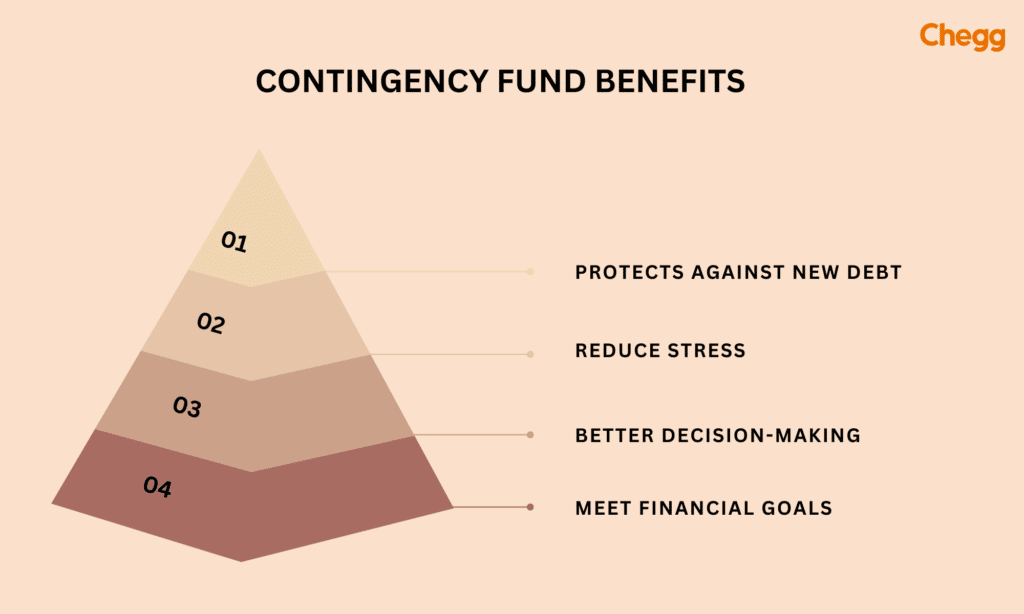
Quick Summary
Table of Contents
The India Contingency Fund is a fiscal safety net, a financial cushion protecting the government against unplanned and urgent expenses. It is a critical resource when regular budgetary allocations fall short, giving a rapid and necessary answer to address emerging financial demands.
Under the administrative power of the President of India, Article 267 of the Indian Constitution established the Contingency Fund. This constitutional clause gives the government the authority to lay aside cash for unanticipated occurrences, providing a timely reaction to financial emergencies.
Contingency Fund Article 267, which expressly enables the development of such reserves, serves as the foundation for the distribution and establishment of the Contingency Fund. This constitutional support emphasizes the significance of having a conveniently available fund to handle urgent and unforeseen financial needs.
The Contingency Fund runs with a nominal amount sanctioned by Parliament at the outset. The purpose of this fund is to offer a quick reaction mechanism in emergencies, not to cover ongoing expenditures. With legislative permission, the government can use this fund to fulfill emergency budgetary requirements, providing a quick and effective reaction to unanticipated circumstances.
The Contingency Fund of India exhibits cautious fiscal planning in the Indian context, exhibiting the government’s dedication to financial readiness and responsiveness in the face of risks.
The Contingency Fund of India is a crucial financial mechanism established under Article 267 of the Indian Constitution. It serves as a reserve fund to address unforeseen expenditures that cannot be postponed until the Parliament convenes. Here’s an overview of its key features and significance:

Funds are essential to the operation of any economy, and in India, they play a variety of functions to satisfy particular financial demands. Let’s look at three essential types of funds, each serving a specific role within the Indian financial structure.
The Consolidated Fund is the financial backbone of the government. This fund receives all revenues, loans, and repayments. The government gets funds for its monthly costs from the Consolidated Fund, stressing openness and responsibility in public financial management. This fund guarantees that a consolidated pool of resources supports the government’s day-to-day operations, contributing to an organized and responsible fiscal system.
Instead of the Consolidated Fund, the Public Account serves particular financial transactions. It includes debt, deposit, and advance transactions, allowing for the segregation of some financial processes. The money in the Public Account, unlike the Consolidated Fund, does not contribute to the government’s consolidated financial statement. This fund allows the government to manage specified financial initiatives without affecting its operating budget, improving financial efficiency.
The Contingency Fund, created under Article 267 of the Indian Constitution, functions as a critical financial safety net. They have set it up for unanticipated and emergency costs. This fund represents the government’s commitment to fiscal readiness, allowing for a rapid reaction to unforeseen occurrences such as natural catastrophes or economic crises. This fund strengthens the government’s ability to deal with unexpected financial issues by establishing a specified reserve.
Each fund has a distinct purpose, such as financing recurring spending and facilitating targeted financial transactions. Understanding the complexity of India’s economic management and financial decision-making requires understanding the subtleties of these funds.
A Contingency Fund is a financial reserve set aside by an organization, government, or entity to cover unexpected expenses or emergencies that arise suddenly and cannot be anticipated in advance. This fund is designed to provide immediate financial resources for urgent needs without requiring prior approval or lengthy bureaucratic processes.
Article 267 of the Indian Constitution grants authorities to establish and maintain the fund. This constitutional clause allows the government to establish a fund specially designated for unanticipated contingencies, emphasizing the need to be prepared in the face of unforeseeable circumstances.
The Contingency Fund of India Act 1950 strengthens the Contingency Fund. This Act establishes a legal framework for the fund’s control and usage. It specifies the processes for declaring and refilling the fund and assuring openness and accountability in its administration.

The Controller General of Accounts (CGA) plays a pivotal role in the financial management and accountability of the Government of India. As the principal accounting authority, the CGA is responsible for ensuring the integrity and accuracy of government accounts, thereby acting as a guardian of public funds.
The Contingent Fund of India is held by the Finance Secretary of the Department of Economic Affairs on behalf of the President of India. This fund is used to address unforeseen expenditures that require immediate financial resources.
The Parliament authorizes a modest allocation to the Fund . The President of India, on the recommendation of the Union Cabinet, can tap into this fund in the event of an emergency financial need. India’s Comptroller and Auditor General (CAG) oversee the audit and accounting parts, giving a degree of responsibility to the fund’s usage
The primary goal of the Contingency Fund is to give urgent financial assistance in the case of an unanticipated incident. By establishing this fund, the government assures that it can respond quickly and efficiently to unanticipated crises, improving its overall budgetary resilience. Here’s a quick overview of how to utilize it:
The enlarged comparison emphasizes the multidimensional character of differences between the Consolidated Fund, Contingency Fund, and Public Account of India. Each one of them serves a distinct purpose in India’s financial architecture. This in-depth examination emphasizes the significance of these funds in preserving financial stability, responding to eventualities, and supporting targeted financial activity.
| Aspect | Consolidated Fund | Contingency Fund | Public Accounts of India |
| Under Article | This fund was adopted under Article 266 of the Indian Constitution | This fund was adopted under Article 267 of the Indian Constitution | This fund was adopted under Article 266 and Article 266 (3) of the Indian Constitution |
| Purpose | The aim is to core fund for routine government expenses | The goal of this fund is to act as a financial safety net for unforeseen contingencies | This fund’s aim is only to utilize it for specific transactions and activities such as debt, deposits, and advances. |
| Expenditure | The expenditure is almost daily, as used in regular day-to-day expenses. | The fund is also spent during urgent and unforeseen situations. | The expenditure is based on specific transactions and activities specified by the law. |
| Income | This fund is generated from all revenues, loans raised, and money received in repayment of loans. | The fund is generated by initial nominal allocation by the Parliament. | This fund is collected via receipts of loans raised by the government, deposits, and advances made by the government. |
| Handling Of The Fund | The Government has control over the day-to-day operations and utilization of this fund. | The President of India controls this fund on the advice of the Union Cabinet. | This fund is governed by rules and procedures specified by law, under the control of the executive. |
| Audit Oversight | The fund is audited by the Comptroller and Auditor General (CAG) | The CAG audits this fund for accounting aspects | This fund is subject to audit by the CAG to ensure financial regularity and propriety. |
| Transparency and Accountability | Emphasizes transparency and accountability in government spending | Provides a legal framework through the Contingent Fund of India Act, of 1950 | Governed by rules and procedures to ensure transparency and accountability |
| Withdrawal Process | It requires parliamentary approval for withdrawals | The withdrawal of this fund is only possible with presidential approval based on the advice of the Union Cabinet | Since this is governed by law, there are specifying conditions and procedures for withdrawals |
| Replenishment Mechanism | Not applicable, as it is continually replenished through government revenues | Requires replenishment through parliamentary approval | Replenished through receipts of transactions and activities defined by law |
| Utilization Oversight | Subject to parliamentary scrutiny and oversight | Governed by the rules and procedures outlined in the Contingent Fund of India Act, of 1950 | Oversight ensures compliance with legal provisions and regulations |

The Contingency Fund functions as a financial bulwark, providing a variety of significant advantages that help the country’s economic resilience and wise financial management.
One of the most important benefits of this Fund is that it protects the government from incurring new debt during unforeseen financial pressure. The government may manage urgent and unanticipated needs without resorting to new borrowing by keeping a set reserve. This not only avoids debt accumulation but it also ensures the country’s financial soundness. It encourages fiscal discipline and sustainability, consistent with the overarching objective of maintaining a stable and resilient economic structure.
Overcoming financial issues without incurring new debt is critical during economic downturns or unexpected emergencies. It not only protects the government’s financial position, but it also has a long-term influence on the national economy. This prudent use of this fund allows the government to respond effectively to emergencies while maintaining budgetary integrity, which is critical for long-term economic success.
During uncertainty and disaster, the Contingent fund is critical to stress reduction. It offers considerable financial protection in the event of a major economic shock, natural calamity, or public health emergency. This guarantee not only relieves government tension but also has a more considerable favorable influence on public attitudes. It increases trust in the government’s ability to handle crises properly and supports a sense of stability and dependability in governance.
Furthermore, stress reduction affects the larger economic environment. The government may adopt significant changes without succumbing to the pressures of immediate economic restrictions by putting a financial safety net in place. This, in turn, helps to stabilize financial markets by comforting investors and maintaining overall economic confidence.
The Contingency Fund aids in informed and strategic decision-making, especially during unexpected situations. The flexibility offered by a reserve for unexpected expenses enables the government to make timely and wise financial decisions without endangering the stability of ordinary operations. This adaptability is critical for preserving public services, promoting economic recovery, and responding quickly to unforeseen difficulties.
The capacity to make well-informed judgments quickly during a crisis might be the difference between successful crisis management and a lasting economic impact. This fund enables the government to move decisively, strategically deploy resources, and execute policies that address the population’s immediate needs. This proactive decision-making power improves the government’s overall governance and crisis response efficacy.
This fund helps the government keep on track with its budgetary goals even in the face of unanticipated circumstances. The government may continue to pursue its long-term financial goals without diverting resources away from critical initiatives by keeping a dedicated reserve for urgent expenses. This supports the continuance of developmental activities while also reinforcing the government’s commitment to meeting its financial objectives.
In practice, the government’s ability to fulfill budgetary targets during times of crisis or uncertainty demonstrates its resilience and commitment. It exhibits a forward-thinking approach to financial planning and governance, demonstrating the government’s commitment to its development program even under challenging conditions. This helps to maintain public trust and strengthens the legitimacy of the government’s fiscal stewardship.
The Consolidated Fund of India (Article 266), the Contingency Fund of India (Article 267), and the Public Accounts of India (Article 266) are three important funds established by the Indian Constitution for the efficient management of the government’s finances. For both federal and state disaster management, the Contingent Fund is essential.
The Contingency Fund is a critical component of financial resiliency and intelligent governance. Its numerous advantages, ranging from protecting against additional debt to lowering stress, facilitating improved decision-making, and enabling the pursuit of financial objectives, highlight its critical significance. The Contingency Fund, as a proactive tool, not only navigates uncertainty successfully but also enforces fiscal responsibility principles, assuring national stability and sustained economic progress.
Read More:-
This is known as an amount of money set aside in a project estimate or budget for unforeseen costs or changes to the scope of work, serves as a risk management tool benefiting both the contractor and the owner. It functions as “insurance” to cover the cost of things that cannot be estimated in advance.
A contingency is an unfavorable event that could happen in the future, like fraud, a natural disaster, or a downturn in the economy. Businesses and investors analyze potential outcomes and put preventative measures in place to prepare for a variety of scenarios.
The Indian President holds it. To compensate, the Consolidated Fund of India deducts an equal amount of money. Currently, this fund corpus is valued at about Rs 30,000 crore.
The Contingency Fund of India, established under Article 267 of the Constitution, is an emergency fund that allows the government to meet urgent and unforeseen expenditures without prior parliamentary approval. Managed by the President of India through the Finance Secretary, it acts as a quick-response financial buffer for crises, later replenished through a supplementary grant passed in Parliament.
The Contingency Fund of India is held by the President of India and managed by the Finance Secretary of the Department of Economic Affairs, who oversees its utilization for urgent expenditures.
The Reserve Bank of India and its branches hold accounts for all three funds of the Indian government.
The consolidated fund is the most significant of the three, as it includes all the taxable and non-taxable revenues of the Indian government.
The corpus of the Contingency Fund of India is currently set at ₹500 crores. This fund is used for urgent and unforeseen expenditures, allowing the government to respond quickly to emergencies.

Authored by, Muskan Gupta
Content Curator
Muskan believes learning should feel like an adventure, not a chore. With years of experience in content creation and strategy, she specializes in educational topics, online earning opportunities, and general knowledge. She enjoys sharing her insights through blogs and articles that inform and inspire her readers. When she’s not writing, you’ll likely find her hopping between bookstores and bakeries, always in search of her next favorite read or treat.
Editor's Recommendations
Chegg India does not ask for money to offer any opportunity with the company. We request you to be vigilant before sharing your personal and financial information with any third party. Beware of fraudulent activities claiming affiliation with our company and promising monetary rewards or benefits. Chegg India shall not be responsible for any losses resulting from such activities.
Chegg India does not ask for money to offer any opportunity with the company. We request you to be vigilant before sharing your personal and financial information with any third party. Beware of fraudulent activities claiming affiliation with our company and promising monetary rewards or benefits. Chegg India shall not be responsible for any losses resulting from such activities.